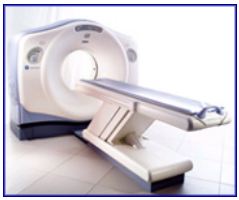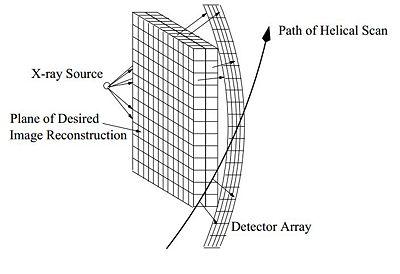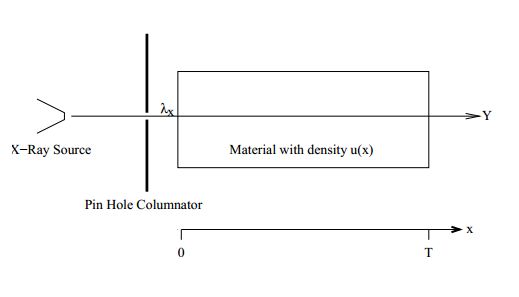The Bouman Lectures on Image Processing
A Slecture by Maliha Hossain
Subtopic 2: Computed Tomography (CT)
© 2013
Contents
[hide]Excerpt from Prof. Bouman's Lecture
Accompanying Lecture Notes
Computed Tomography or CT is an imaging technique that uses an X-ray source and an array of detectors to produce tomographic images of an object. CT is commonly used in medical imaging for diagnosis. It also has applications in industry for imaging internal and external components. CT is also used in airport security.
In this set of notes, we will cover the basics of the physical design of CT scanners and derive the differential equation and line integral needed for the inversion process using convolution back projection
Physical Design and Data Acquisition
Figure 1 shows a CT scanner for medical imaging. The patient lies down on the bed which is then translated through the scanner. The gantry is equipped with an X-ray source across from a detector array behind a fiberglass cover. The rays have a cone-beam structure. Figure 2 shows the orientation of the source and the detector array relative to the object being scanned. As the bed passes the rotating gantry, multiple data scans are collected and processed in real time. The path traced by the gantry relative to the patient is helical, hence the term helical multislice scan CT.
Photon Attenuation
During a CT scan, the X-ray source emits photons that travel in a straight line towards the detectors. With each increment of distance traveled, there is a probability that a photon is either absorbed or able to reach the detector array. This is of course an approximation. When we say that a photon is absorbed, what we really mean is that it is scattered. When a photon collides with a particle, its direction changes and its wavelength increases. It is assumed that the resulting energy loss is large enough so that the detector array is no longer sensitive to it. These scattered photons eventually turn into heat that is absorbed by its surroundings.
So under these assumptions, a photon that emerges from the source either stops or goes on its way to the detector array without hindrance.
The X-rays emitted by the source are focused using a pinhole collimator. This is similar to how light rays are focused by a lens but the wavelength of X-rays is so short that a diffraction effects are negligible and the pinhole is sufficient for focusing the X-rays reasonably accurately in terms of physical distances. So we can assume that the X-rays emerging from the pinhole travel in a straight line.
Let $ x $ be the depth into the material measured in cm.
Let $ Y_x $ be the number of photons at depth $ x $.
Let $ \lambda_x = E[Y_x] $ be the expectation of the number of photons at depth $ x $.
The number of photons at depth $ x $ can be modeled as a Poisson random variable.
$ P\{Y_x = k\} = \frac{e^{-\lambda_x}\lambda_x^k}{k!} $
where $ P\{Y_x = k\} $ is the probability that there are $ k $ photons at depth $ x $ cm.
let the density of the material to be scanned be $ u (x) $
Beer's law implies that the for the rate of absorption of photons is proportional to the number of photons entering the material and the density of said material. Therefore we can form the following differential equation
If you look at an increment of distance the photons travel through, namely $ dx $, $ \lambda_x $ is the average number of photons entering voxel of depth $ dx $. So how many photons are absorbed within this voxel? We have that
$ -\Delta\lambda_x = \lambda_x\mu(x)\Delta x \ $
That is to say that the change in the number of photons is proportional to the material density and the distance traveled and the original number of photons. Since all these factors are positive quantities, the minus sign must be included as the change is a decrease in the number of photons. Remember that photons can only be absorbed. New ones are created only at the source. So we have that
$ \frac{d\lambda_x}{dx} = -\mu(x)\lambda_x $
where $ \mu(x) $ is the density of the material as a function of depth and has units of cm$ ^{-1} $.
By integrating this differential equation, we see that
$ \lambda_x = \lambda_0 e^{-\int_0^x \mu(t)dt} $
where t is just a dummy variable; it has nothing to do with time.
If you have studied differential equations, you will recall that this solution is unique given a boundary condition, $ \lambda(0) $. So essentially, this equation is saying that the number of photons emerging from a voxel is equal to product of the number of photons entering and the attenuation factor.
The attenuation factor is given by the ratio of $ \lambda(x) $ to $ \lambda(0) $
$ \frac{\lambda(x)}{\lambda(0)} = e^{-\int_0^x \mu(t)dt} $
Since the density of the material, $ \mu(x) $ is always positive, so is its integral. The exponent is therefore always negative. This reiterates the notion that photons can only be absorbed or attenuated. In other words, the number of photons reaching the detector array has an upper bound equal to the number of photons leaving the source.
Taking the log of both sides, we have that
$ \begin{align} \int_0^x \mu(t)dt &= -log(\frac{\lambda_x}{\lambda_0})\\ &\approx -log(\frac{Y_x}{\lambda_0}) \end{align} $
The log of the ratio of $ \lambda(0) $ to $ \lambda(x) $ is the quantity measured by the CT scanner. This is the line integral that is measured by the system. These measurements are collected across the object at a fixed angle to produce the projection for that particular angle. The process is then repeated for different angles to obtain different projections to be used in tomographic reconstruction.
Typically the technician will perform an air calibration to obtain $ \lambda(0) $ at the start of the day. That basically means that a scan will be performed when the cavity inside the scanner is empty.
Estimate of photon integral
A commonly used estimate of the projection integral is
$ \int_0^T \mu(t)dt \cong -log(\frac{Y_T}{\lambda_0}) $
where $ \lambda_0 $ is the dosage and $ Y_T $ is the photon count at the detector.
Once the integral is obtained, the next step would be to reconstruct the image of the slice using convolution back projectionconvolution back projection, which is covered in a later set of notes. The process is repeated across the patients body to produce multiple slices that together represent a 3-dimensional volume.
References
- C. A. Bouman. ECE 637. Class Lecture. Digital Image Processing I. Faculty of Electrical Engineering, Purdue University. Spring 2013.
Questions and comments
If you have any questions, comments, etc. please post them on this page
Back to the "Bouman Lectures on Image Processing" by Maliha Hossain




